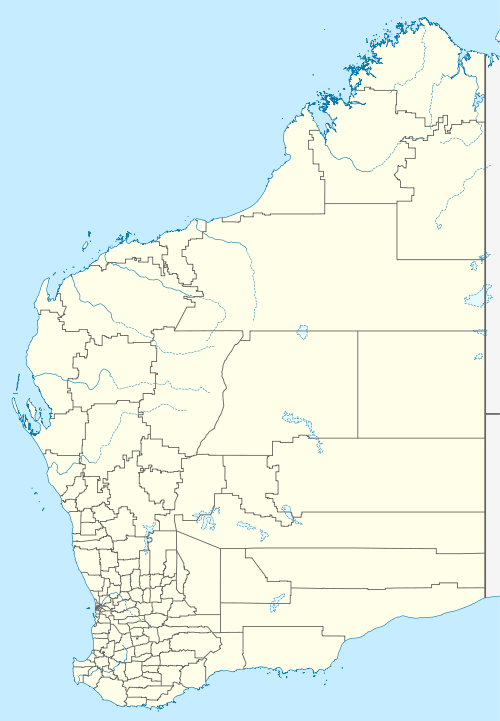Camden Sound
Camden Sound is relatively wide body of water in the Indian Ocean located in the Kimberley region of Western Australia.


Camden Sound is bounded by the Bonaparte Archipelago to the east, the Buccaneer Archipelago to the west, and Montgomery Reef to the south. There is no road access and the nearest town is Kalumburu, 268 km (167 mi) to the east.[1]
Camden Sound was discovered by Captain Phillip Parker King on HMS Bathurst on 15 August 1821. He named the sound Camden Bay after John Pratt, 1st Marquess Camden.[2]
Camden Harbour was a short lived settlement within the sound.
The area is a drowned valley in the western end of the MacDonald Range, the islands that are found within the sound are remnant emergent features formed by basalt and sandstone formations.[3] Camden Sound includes Augustus Island, at its northern extent, Champagny, Byam Martin and the Heywood Islands to the West, Bumpus Island, Rice Rocks, Sampson Inlet, Deception Bay and Prior Point to the South. As with the rest of the Kimberley coast, the area is marked by an extreme tidal variation of up to 11 m (36 ft) on a spring tide.
The area has received worldwide recognition as a crucial breeding and calving area for the Breeding Group D population of humpback whales (Megaptera novaeangliae) – at approximately 22,000 individuals, the world's largest humpback whale population.[3] The calves are suckled in the warm, tropical waters for several months until they gain the strength for the journey back to the Antarctic for summer feeding. Camden Sound is rich in other cetaceans including the Australian snub-fin dolphin (first described as a separate species in 2005), blue whales, pygmy killer whales, pilot whales and bottlenose dolphins. In addition, the area is surrounded by fringing reefs with hard and soft corals, turtles, molluscs, fish and marine invertebrates.[4]
In October 2009, Donna Faragher, Western Australia's Environment Minister, announced that Camden Sound would become the Kimberley's first Marine Park, largely in recognition of the area's status as nursery and breeding area to the world's largest population of humpback whales.[5]
The Camden Sound Marine Park was the first of four new marine parks announced under the Kimberley Science and Conservation Strategy, and covers an area of 7,062 km2 (2,727 sq mi). The park is the second largest in Western Australia after Shark Bay and links to the Prince Regent National Park.[6] The area includes Montgomery Reef, Champagny Island and St George Basin.[7]
The marine park will encompass several different zones, including a whale sanctuary zone of approximately 1,067 km2 (412 sq mi), two sanctuary zones comprising about 20% of the marine park area around Champagny Islands and Montgomery Reef, a pearling industry zone and general use zones. Another 48% of the park will be closed to trawling and 23% of the park closed to commercial fishing.[8]
The marine park recognises two broad themes:
- Habitat - comprising both geomorphic habitat (such as rocky shores and platforms) and biological habitat (such as seagrass)
- Species of special conservation interest - comprising those species which are listed as having special conservation status (such as humpback whales) as well as species which are extracted for human use (such as targeted finfish).
Three native title claims have been registered in the area of the marine park by the Dambimangari, Uungu and Mayala native title groups. The Dambimangari claim lies over the majority of the park, with the Uungu claim overlying a small portion of the St George Basin, and Mayala at the southwestern end of the park.[3]
References
- "Bonzle Digital Atlas – Map of Camden Sound". 2009. Retrieved 18 March 2009.
- King, Phillip Parker (1827). Narrative of a Survey of the Intertropical and Western Coasts of Australia performed between the years 1818 and 1822. Volume 2. London: John Murray. Retrieved 17 February 2015.
- "Proposed Camden Sound Marine Park Indicative Management Plan" (PDF). 2010. Retrieved 24 April 2012.
- "Kimberley Whale and Cetacean Survey". 2009.
- "Media Statement – Announcement of Camden Sound Marine Park" (PDF). 2009. Archived from the original (PDF) on 2 April 2011. Retrieved 28 October 2009.
- "Department of Environment - Camden Sound Marine Park". 2012. Archived from the original on 20 April 2012. Retrieved 24 April 2012.
- "Bill Marmion — 18 June 2012". Liberal Party of Australia. 18 June 2012. Archived from the original on 19 August 2014. Retrieved 17 August 2014.
- "Media Statements - New Marine Park to protect Kimerley Coast". 2012. Retrieved 24 April 2012.